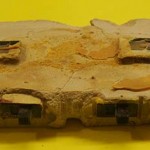I was hoping to do a quick article on DIY reverse engineering, but was thwarted by a little bit of intellectual property protection!
My subject of study was the Rhythm Bandit, a product by Lueken Innovations. I acquired this particular unit from a garage sale for cheap and was not impressed by the rhythm guitar isolation the box promised me. One of the input jacks needed a replacement, so I decided to open it up and take a look under the hood.
After unsuccessfully finding screws that typically are used to hold plastic enclosures together, I realized that glue was involved. I drilled a tiny hole with a Dremel and used a screwdriver as a wedge. The glue was holding tight and I noticed something very odd as I pried the case open: the entire circuit was encased in a hard plaster-type material. No small obstacle, but I was determined to find the circuit.
I decided to hammer and scrape to get to the circuit board until the circuit was revealed to me. I learned a couple of things about the Rhythm Bandit:
1) No circuit board
2) It’s mostly wiring
3) It’s a very simple circuit (probably a passive RC (Resistor-Capacitor) low pass filter, as it doesn’t require batteries)
4) It was encased in plaster
It would probably be close to the truth to assume that the Rhythm Bandit design was “protected” by the plaster so that competitors could not reverse engineer the circuit and to give the box some weight. However, I think that Lueken did this to make a simple circuit appear much more complex than it actually is, and sell it for more. You’d be pretty pissed if you opened up an expensive guitar effect and found that all there was to it was a resistor and a capacitor.
Anyway, a passive RC low pass filter costs less than $0.50 to make and gives some decent results. I’ll post one shortly, and then you too can become a Rhythm Bandit!
Take a look at the pictures below if you’re curious!























One Comment on “Rhythm Bandit by Lueken Innovations Teardown Fail!”